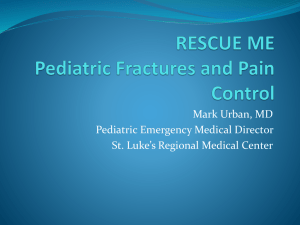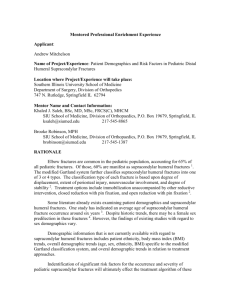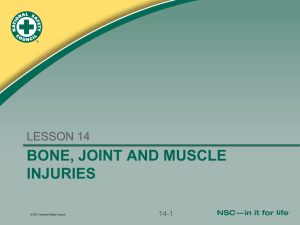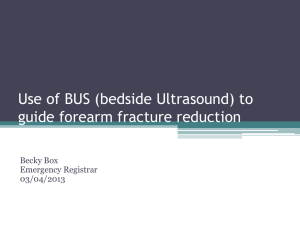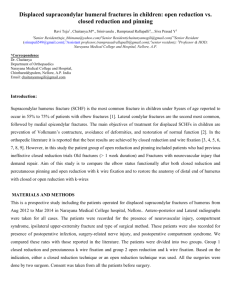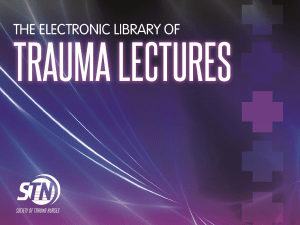Common Pediatric Fractures compressed
advertisement
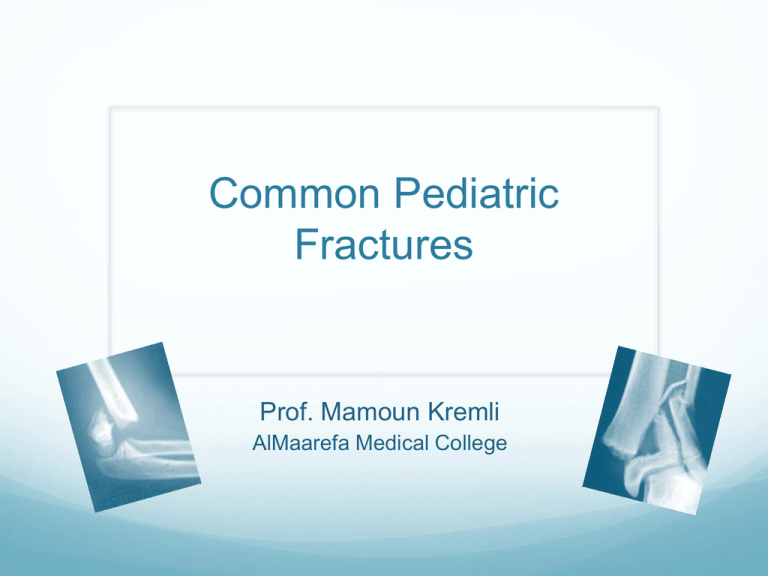
Common Pediatric Fractures Prof. Mamoun Kremli AlMaarefa Medical College Objectives • How are children’s fractures different • Discus common fractures in children • X-ray diagnosis • Principles of management • Identify Epiphyseal injuries • Precautions Statistics • ~ 42% of boys and 25% of girls, are expected to have a fracture during childhood (Landin 83) • Percentage of children sustaining a fracture in 1 year: 1.6% to 2.1% (Warlock &Stower 86) Mamoun Kremli Statistics • ~ 42% of boys and 25% of girls, are expected to have a fracture during childhood (Landin 83) • Incidence increases with age – peak ~ 12-14 yrs Mizulta, 1987 Introduction • In Middle East ~50% of population < 20 yrs • Different from adult fractures • Varies in various age groups Statistics Most frequent sites 47% 74% , Mizulta, 1987, (923 children) Fractures specific to children • Greenstick • Torus (buckle) • Deformation • Physeal injuries www.radiologyassistant.nl/ www.wheelessonline.com/ Mamoun Kremli www.imageinterpretation.co.uk/ Different from adults • Ends of long bones have thick cartilage: • Not seen on x-rays • Thick periosteum, good blood supply: • Heal well and quickly • More elastic, more cancellous: • Incomplete fractures, simple fractures • Growth plate: • Good remodeling • Special growth plate injuries The power of remodeling • Can accept more angulation and displacement • Rotational mal-alignment ?does not remodel www.brokenarmanswers.com/ The power of remodeling • Can accept more angulation and displacement • Better remodeling near growth plates The power of remodeling http://www.acep.org/ The power of remodeling Treatment Choice of treatment • Stable fractures - incomplete: • Greenstick • Buckle (Torus) • Plastic deformation • Stable fractures – complete: • Undisplaced • Displaced, reducible • Unstable fractures: • • • • Bothe bones at same level Oblique fractures Comminuted fractures Preference (patients’ / surgeons’, choice) Closed reduction • More commonly used in children Closed reduction - Casting • Still the commonest • Good remodeling power • Needs careful monitoring • Regular follow-ups • Swelling subsides: • cast loose • displaces Casting - Problems • Forearm is a joint – needs anatomic reduction • Mal-union results in loss of supination/pronation Casting - Problems • Mal-alignment in LL causes osteoarthritis Gicquel Casting - Problems • Overlap – shortening • Loss of reduction Casting - Problems 9 yr old 6 yr old - 5wks K Willkins, Injury Suppl 36 Surgical treatment • K-wires • Intramedullary nails • Plates • External Fixator K-Wires • The commonest in children • Very effective • Prevents displacement • Needs additional casting • Application: • Percataneous • Open Elastic IM Nails • Unstable fractures – minimal surgery P. Schmittenbecher Plating • For overweight children • Problems: • Large scars • Needs removal Plating • Bridge plating • MIPO: • Introduced through small wounds External fixator • Open (compound) fractures www0.sun.ac.za/ortho Common injuries • Clavicle • Radius • Forearm fracture – fracture dislocation • Supracondylar Humerus • Epiphyseal injuries • Non-accidental injuries • Precaution Clavicle fracture http://parkingspot.wordpress.com/ • Common • Birth injury • Pseudo-paralysis • Fall on outstretched hand • Heals well conservatively • No functional problems • Treatment: • Sling or figure of 8 bandage Supracondylar fracture Supracondylar humerus • A common injury • Fall on the outstretched hand, elbow hyperextended • Anatomically thin part of lower humerus • Nerve or vessel injury possible Supracondylar humerus • Fall on outstretched hand - Hyper-extension of elbow (the commonest type) Anterior www.radiologyassistant.n Supracondylar humerus • Fall on outstretched hand - Hyper-extension of elbow (the commonest type) Anterior www.radiologyassistant.n Supracondylar humerus • Fall on outstretched hand - Hyper-extension of elbow (the commonest type) Anterior www.radiologyassistant.n Supracondylar humerus • Fall on outstretched hand - Hyper-extension of elbow (the commonest type) Anterior www.radiologyassistant.n Supracondylar humerus • Fat pad sign www.radiologyassistant.n www.radiologyassistant.n Fat pad sign • Fat pad sign: • Indicates a fracture www.radiologyassistant.nl/ X-ray lines in elbow • Anterior humeral line • A line drawn on a lateral view along the anterior surface of the humerus should pass through the middle third of the capitellum Abnormal Normal www.radiologyassistant.nl Supracondylar fracture • Classification (Gartland’s) http://tidsskriftet.no/ Undisplaced Posterior intact Completely displaced Supracondylar humerus • Needs immediate care • Nerve injury: Median N, Radial N • Vascular injury: Brachial artery (tenting) • Swelling: compartment syndrome www.wheelessonline.com/ www.mendelsonortho.com/ Supracondylar humerus • Needs immediate care • Delay causes more swelling • More difficulties in reduction • More vascular compromise • Undisplaced: Casting • Displaced: • Closed reduction and fixation with K-wires • ? Open reduction and fixation with K-wires 6y girl, fell from swing Injury reduction Teddy Slomgo, Bern, Switzerland 3m 2 yrs Supracondylar humerus • Closed reduction and percutaneous K-wires Teddy Slomgo, Bern, Switzerland Supracondylar humerus • Neurovascular injury must be ruled out • Swelling and possible kinking of vessels • May cause Volkmann's ischemia • A real emergency www.studyblue.com Supracondylar fractures • Most are displaced and need surgery • Type I can be managed with long arm cast, forearm neutral, elbow 90o for 4 wks • Bivalve cast if acute • Follow-up xrays 3-7 days later to document alignment • Xrays at 4 weeks to document callus • Once callus noted at 4 weeks, discontinue cast and start active ROM Supracondylar fractures • Delayed complication • Malunion • Often cubitus varus deformity Lateral condyle - humerus • Mostly cartilaginous • Fracture may be easily missed • Displacement may not be appreciated • Needs fixation even if undisplaced • If not fixed, may displace www.radiologyassistant.nl Forearm – Radius and Ulna • A joint: supination and pronation • Anatomical reduction is a must • Treatment: • Closed reduction and casting • Closed reduction and intramedullary nail Closed reduction and casting • Good method if reduction maintained • Needs close, regular follow-up http://eorif.com/ Intramedullary nail • When unstable, or re-displace in cast Teddy Slongo, Bern, Switzerland Plating Kelly D. Carmichae, Orthop 2007 Lower Radius • Torus (Buckle) • Treatment: • Casting • Complete: • Treatment: • Conservative • ? K-wire if unstable www.radiologyassistant.nl/ Parikh, Orthopedics, June 2013 Fracture Dislocation • Montaggia • Fracture ulna, dislocation of head of radius • Galiazzi • Fracture radius, dislocation of distal radio-ulnar joint www.mysportphysio.com Monteggia • Fracture of shaft of ulna, dislocated radial head • May be missed if two joints not seen on x-ray www.medisuite.ir/medscape Monteggia • Fracture of shaft of ulna, dislocated radial head • May be missed if two joints not seen on x-ray www.medisuite.ir/medscape X-ray lines in elbow • Radio-capitellar line • A line drawn through the center of the radial neck should pass through the center of the capitellum in all views www.radiologyassistant.nl/ X-ray lines in elbow • Radio-capitellar line • A line drawn through the center of the radial neck should pass through the center of the capitellum in all views • If not: dislocated radial head www.radiologyassistant.nl/ Monteggia fracture • Treatment: • Reduce ulna • Reduce head of radius Galeazzi fracture • Fractured radius, with • Dislocation of distal radio-ulnar joint • Treatment: • Reduction of radius • Reduction of DRUJ www.pemcincinnati.com Femur • Problems: • Bleeding • May bleed more than 1 L • Conservative treatment: • Shortening, mal-union • Operative treatment: • Another surgery to remove implants Femur • Conservative: e.g. 5 year old • Hip spica cast • 1-2 cm shortening will be compensated by growth http://orthoinfo.aaos.org/ AAOS guidelines, E. Sink Femur • Operative: in older children • Good alignment and length • Nailing better than plating AOFoundation.org AAOS. J. Beaty Tibia • Direct Vs. indirect injury • Soft tissue injuries • Compartment syndrome • Need to correct • Alignment, rotation, and length Closed reduction - ESIN • Closed reduction and casting • Closed reduction and nailing • Open reduction and plating - less Physeal injuries • Incidence: • About 15-20 % of all skeletal injuries in children • 50% occur in the distal radius • Problem: • Possibility of growth affection • Some are intra-articular Physeal anatomy Epiphysis • Physis: 4 zones • Germinal zone • Proliferative zone • Hypertrophic zone Weakest zone - fractures • Enchondral ossification Metaphysis Physeal injuries More common in • Boys • Peak ~ 12y of age • Upper limb Classification – Salter- Harris Most common I II III 75% IV V Treatment – Salter Harris I • Closed reduction • Fixation if unstable only Treatment – Salter Harris I • Closed reduction • Fixation if unstable only Treatment – Salter Harris II • Need good stable reduction • Possibly closed reduction, percutaneous fixation Treatment – Salter Harris III • Intra-articular • Anatomic reduction, stable fixation Treatment: Salter Harris IV • Intra-articular • Anatomic reduction and stable fixation Treatment – Salter Harris V • No treatment available ! • Diagnosed in retrospect ! Complete Physeal affection • Usually seen in Salter-Harris type V Injury films Injured and uninjured wrists after premature physeal closure Asymmetrical physeal affection • Standard radiography remains the initial imaging evaluation of choice • Oblique Park-Harris growth recovery line Asymmetrical physeal affection • 12Y, male, Salter-Harris II 3y post injury Beware! • Non-accidental injuries • Tumors Beware! Non-accidental injuries • Specific pattern • Femur shaft fracture • <1 year of age • ( 60-70% non accidental) • Transverse fracture Beware! Non-accidental injuries • Specific pattern • Femur shaft fracture • <1 year of age • ( 60-70% non accidental) • Transverse fracture • Humeral shaft fracture • <3 years of age • Sternal fractures Beware! Non-accidental injuries • Specific pattern • Corner fractures (traction & rotation) Beware! Non-accidental injuries • Specific pattern • Bucket handle fractures (traction & rotation) Physical Examination • Undress the child • Look for areas of bruising • Bruises at different stages of healing emedicine.medscape.com Physical Examination • Undress the child • Look for areas of bruising • Bruises at different stages of healing • Bruises take shape of inflicting instrument Physical Examination • Undress the child • Look for areas of bruising • Bruises at different stages of healing • Bruises take shape of inflicting instrument Physical Examination • Undress the child • Look for areas of bruising • Bruises at different stages of healing • Bruises take shape of inflicting instrument Physical Examination • Trunk • Back, palpate rib cage, abdomen mandyb87.weebly.com www.mecourse.com Physical Examination • Head - examine for skull trauma, palpate fontanel's if open, consider funduscopic exam for retinal hemorrhage Physical Examination • A silent child tells the story! Physical Examination • A silent child tells the story! www.kidspot.com.au Consider non-accidental if 1. Delay in seeking medical attention 2. Mechanism incompatible with injury 3. Physical location of injury 4. Vague history, lacking the "real truth" 5. Varying history • e.g. one parent contradicting the other 6. Inappropriate parental attitude or behavior • e.g. lack of concern, over-concern, aggression Consider non-accidental if 7. Inappropriate parent-child interaction 8. Features of failure to thrive or neglect 9. Allegation of assault 10.Signs of prior injury or injuries of different age 11.Characteristic injuries, illnesses or hospital visits 12.Femoral shaft fracture < 2 years 13.Radiological features Beware! Malignant tumors • Can present as injury • History of trauma usual •12 y old girl • History of trauma • Mild tenderness • Periosteal reaction •Diagnosed as injury • 2m later, still tender • Ewings sarcoma Summary • About 50% of population in ME are children • Fractures in children are common • Compare with other side • Closed reduction still good • Surgery might be needed Summary • Supracondylar humerus needs urgent attention • Forearm • a joint – needs good alignment • Look for fracture dislocation in forearm • In lower limb: • maintain alignment, rotation, and length • Epiphyseal injuries • Beware: Non-accidental & Tumors


